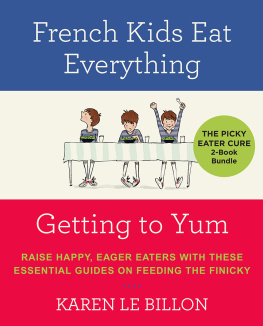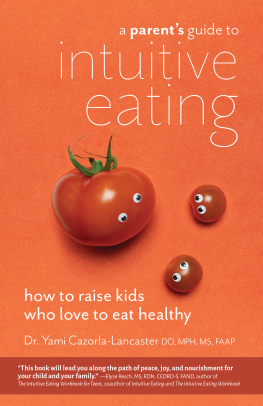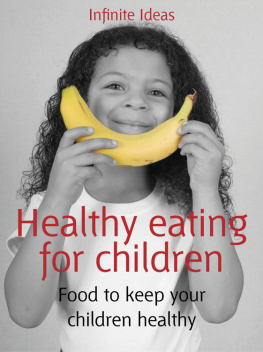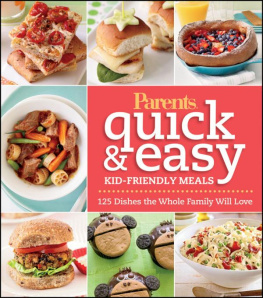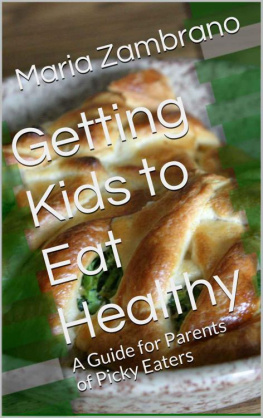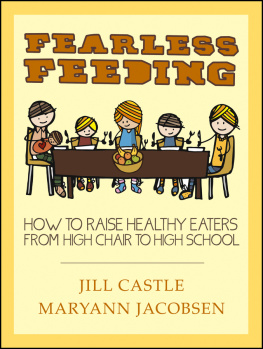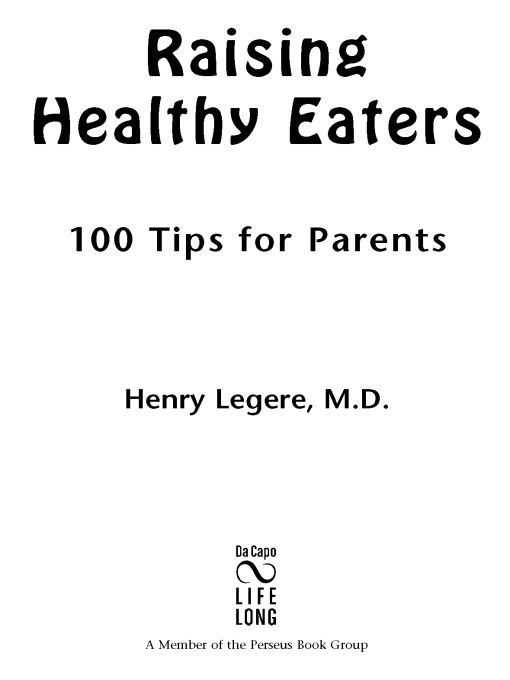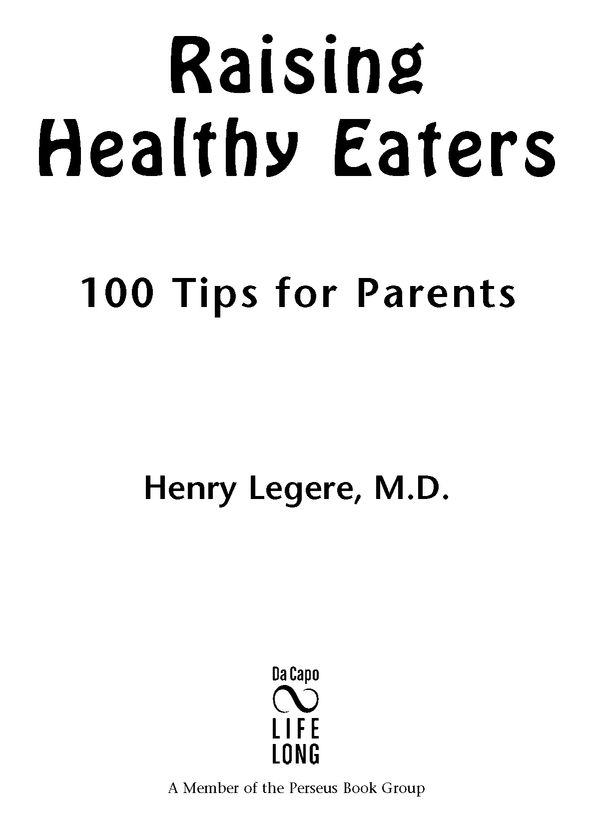Table of Contents
For Claudia and Chloe with love
Introduction
There is an overwhelming amount of information available to parents today concerning everything to do with being a parent. As a pediatrician and advocate for families, I try in every patient encounter to clarify the confusing messages coming from various sources. Of foremost concern to parents during well-child visits is how to raise a healthy eater in a fast-food culture.
Obesity has reached epidemic proportions among our children. Both the American Academy of Pediatricians and the Academy of Family Practitioners have declared as much. The American Medical Association predicts that the increased costs of medical problems resulting from obesity will cost society billions of dollars in the years to come. In addition to the morbidity associated with obesity, the consequences of poor dietary habits include increased risk of heart disease, stroke, diabetes, vision loss, renal disease, and certain types of cancer.
Given this information, you might be tempted to put your chubby little baby on a diet. However, as a general rule, children should not diet! Some dieting, when implemented by a pediatrician, may be safe and even warranted. However, children who begin deprivation diets start the vicious cycle of yo-yoing that can affect their metabolism, their growth, and their endocrine system. The best way to maintain a healthy weight is to maintain a healthy eating regimen from the start. Children who are fit will stay fit. Children who are not fit can engage in the process of becoming fit, adopting patterns of eating and behavior that will increase their lean body mass, their metabolism, their energy level, and their confidence and self-esteem. Healthy eating is a lifestyle, not a fad. As such, it is a process that needs to be learned over years and reinforced by consistent rules and by parents who are good role models.
As a pediatrician, Ive had the opportunity to listen to parents complaints about some of the common obstacles to raising a healthy eater. Furthermore, I have the benefit of mentors who have listened to parents complaints for some twenty to thirty years longer than I have and who have seen what works and what doesnt. This book is the by-product of all that combined experience. The 100 tips provided here can serve as your guide to initiating the process of raising a healthy eater.
To make this book as user-friendly as possible, I have organized the 100 tips into six chapters: Understanding Nutrition, The Basic Rules of Raising a Healthy Eater, Troubleshooting for Picky Eaters, Meals, Snacks, and Beverages, Activity, and finally, Nutrition and Health Issues.
Several of the tips provide general dietary lessons that clarify and demystify what it means to eat healthy. Each tip contains an explanation filled with high-yield, easy-to-understand-and-utilize information. One tip provides information on the correct interpretation of the food pyramid and elucidates the role of each meal and the major nutrients. Other tips incorporate this knowledge into meal planning and give additional ideas on attaining the enthusiastic cooperation of our future healthy eaters. Many of the tips are geared to overcoming the common obstacles of healthy eating for specific age groups of children, such as fussy eaters and milk-o-holics.
Some of the tips are addressed to families who are vegetarian or whole-foods consumers, providing healthy recipes and fun activities. In this vein, there are also tips for recognizing the benefits and pitfalls of organic foods. Additionally, I have included several tips for building self-esteem and a healthy body image as part of a healthy dietary regimen as it relates to preventing the eating disorders and medical diseases that can result from unhealthy eating habits.
There is no magic pill, no panacea, that will cure a societys poor eating habits. Parents can do only so much to protect their children. As children get older they become more responsible for their own choices. Unfortunately, some of the choices they make can affect their future health. Each family must make their own choices, and parents must do their utmost to give their children every opportunity to be healthy in the years to come. These tips are geared toward establishing a sustainable dietary regimen that will give children a head start in the lifelong process of healthy eating. Good luck and have fun!
CHAPTER 1
Understanding Nutrition
Nutrition is what we put in our mouths and the mouths of our children. Everything you and your child eat can be broken down into a few groups: things you get energy from, things your body uses to form tissues and bones, things that promote bowel movements, things your body uses to facilitate chemical reactions at the molecular level, and finally, things that can affect your body in other ways, either positively or negatively, like medications or caffeine.
At the simplest level, eating a well-balanced diet with foods from each of the major food groups ensures that you and your children are eating healthy without ever having to think about it. To help keep nutrition simple, here are some tips that address different categories of nutrients.
Tip 1
Carbohydrates should be the foundation of your childrens healthy diets.
Despite the popularity of recent high-protein diets that vilify dietary carbohydrates, carbohydrates are the foundation of a sustainable, healthy diet for you and your kids. Although it is true that excessive carbohydrates are converted to fat, the same can be said of dietary protein and fat. High-protein diets work in the short run because dieters are taking in fewer calories than they are burning. The high-protein foods that are the staple of fad diets are often high in fat, and the long-term effects of high cholesterol on dieters cardiac health are still unknown. Furthermore, much of the weight loss credited to a high-protein diet over the short run is lost water weight. Walking around partially dehydrated is not good for anyone, especially children!
When I give advice to my patients and their parents, I ask myself what I would tell my brothers and sisters about feeding my nephews and nieces, and I think about what I recommend for my own daughter. In sum, I never recommend fad diets to my own family. Small children should certainly not be on nutrient-restrictive diets unless they are followed closely by a pediatrician and dietitian. Teens too should not start dabbling with fad diets, which can begin the lifelong process of yo-yoingrepeated weight loss and weight gainthat plagues so many. Like so many things in life, carbohydrates are good in moderation. That said, whole-wheat bread, brown rice, and wheat pasta are better choices than their white or processed counterparts for the whole family.
Tip 2
Incorporate nonmeat sources of protein into your childs diet.
Giving your child a combination of protein sources is the optimal way to raise a healthy eater. Your children need to consume 10% to 15% of their daily calories from protein sources to ensure adequate growth and tissue repair, but the typical childs diet provides twice the amount of protein needed. Regardless if your child eats too many calories from protein, carbohydrate, or fat, extra calories are stored as fat by his body. The key to healthy eating is understanding that protein is available from sources other than meat, which, in addition to being high in protein, is often high in fat.


